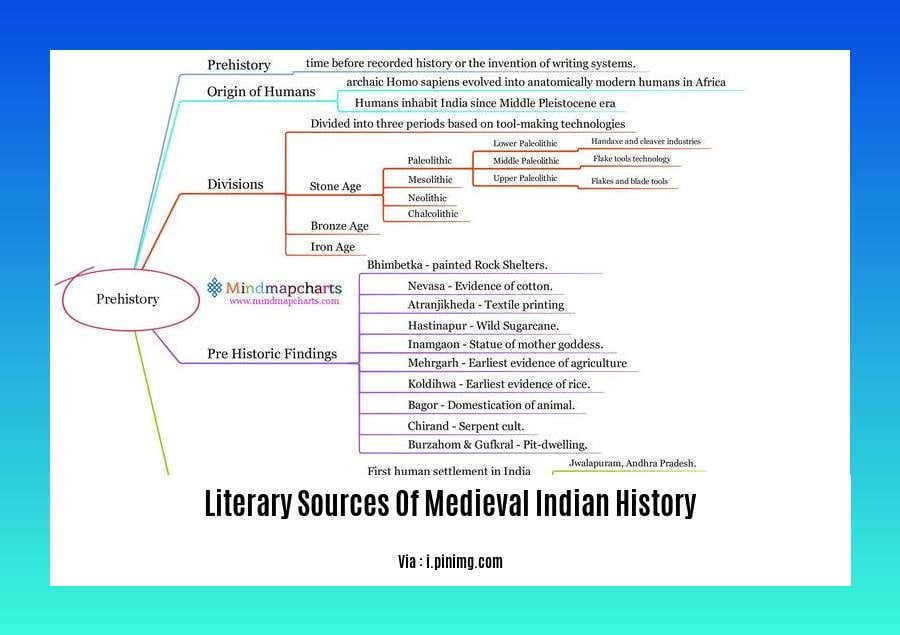Picture this: a time when kings and queens reigned supreme, empires rose and fell, and the vibrant tapestry of Indian civilization was being woven. That’s what medieval India was like, a thrilling era that’s been brought to life by a treasure chest of literary sources. From these ancient writings, we can peek into the fascinating world of medieval India, uncovering the secrets of its rulers, the complexities of its society, and the vibrant culture that shaped a time of incredible change.

Literary Sources: Unlocking the Secrets of Medieval India’s Past
Imagine flipping through a notebook filled with tales from a distant land, where kings ruled with valor, mystics sought enlightenment, and everyday people lived their lives amidst extraordinary events. These notebooks are the literary sources that illuminate the captivating history of medieval India.
Let’s embark on a journey to explore these literary treasures.
Royal Diaries: A Peek into the Courts of Power
Picture yourself as a fly on the wall in the grand courts of medieval India. Royal chronicles, meticulously penned by scribes, offer a privileged glimpse into the lives of kings like Akbar and Firuz Shah Tughlaq. These writings are not just a dry recount of events but a vibrant tapestry woven with the chronicles of conquests, the intricacies of governance, and the splendor of court life.
Epic Sagas: Echoes of History Through Myth
Indian epics, like the Ramayana and Mahabharata, are not mere bedtime stories. They resonate with historical undertones, offering insights into social norms, cultural beliefs, and the struggles faced by people of the time. These epics preserve the essence of medieval India, inviting us into a world where heroes fought for justice and gods walked among mortals.
Persian and Arabic Jewels: Perspectives from Other Realms
Medieval India was a melting pot of diverse cultures, and its literature reflects that richness. Persian and Arabic texts, like the Tarikh-i-Firoz Shahi and the Chach Nama, provide invaluable accounts of the interactions between Muslim dynasties and the indigenous population. These writings offer a window into the political, social, and religious dynamics of the era.
Beyond History: A Tapestry of Society
Literary sources are not merely chronicles of kings and battles. They weave a vibrant tapestry of medieval society. Sufi poetry echoes with the voices of mystics seeking spiritual enlightenment. Religious texts, like the Bhagavad Gita and the Quran, illuminate the spiritual beliefs that shaped the lives of people. Literature reflects the hopes, dreams, and struggles of ordinary individuals, offering a glimpse into their daily lives.
Literary Source Diversity: A Wealth of Perspectives
To piece together the history of medieval India, historians rely on a diverse array of literary sources. From royal chronicles to epics, religious texts, and even travelogues, each source provides a unique perspective on the era. By weaving together these strands of information, historians paint a vivid and comprehensive picture of the past.
Exploring the Past: A Journey into History
Unveiling the history of medieval India through literary sources is a journey filled with challenges and rewards. Historians spend years deciphering ancient scripts, navigating complex symbolism, and unearthing historical context. But with each step, they shed light on a bygone era, bringing the past to life for us to explore and appreciate.
Have you ever wondered about the evolution of the Korean alphabet? Delve into the fascinating history of the Korean alphabet through our comprehensive guide and uncover how it developed into the unique writing system used today.
Ace your O-level History exams with our expertly curated collection of 14-marks questions and answers. Gain insights into key historical concepts and strengthen your exam preparation with our O-level History 14-marks questions and answers.

How do chronicles contribute to our understanding of medieval Indian history?
When we want to know about the past, we often turn to history books. But did you know that some of the most valuable sources of information about medieval India come from chronicles? These are written accounts of events that were recorded by people who lived during that time.
Chronicles are like windows into the past. They give us a glimpse into the lives of ordinary people, the rise and fall of empires, and the cultural and religious practices of the time. By studying chronicles, we can piece together a vivid picture of medieval Indian society.
What kind of information do chronicles provide?
Chronicles can provide a wealth of information about medieval India, including:
- Political history: Chronicles document the reigns of kings and queens, wars, and treaties. They can provide insights into the political landscape of the time and the strategies used by rulers to maintain power.
- Social history: Chronicles offer a glimpse into the lives of ordinary people. They can describe social customs, traditions, and the everyday challenges faced by people in medieval India.
- Religious history: Chronicles can document the rise of new religious movements, the interactions between different faiths, and the role of religion in everyday life.
- Economic history: Chronicles can provide information about trade, agriculture, and other economic activities. They can help us understand how the economy of medieval India functioned and how it changed over time.
- Cultural history: Chronicles can shed light on the arts, literature, and music of the period. They can give us a sense of the cultural life of medieval India and how it was influenced by different factors.
How can we use chronicles to understand medieval Indian history?
Chronicles can be used to understand medieval Indian history in a variety of ways. Here are a few examples:
- They can help us to identify the key events and人物 of the period. Chronicles provide a timeline of events and introduce us to the people who shaped Indian history.
- They can help us to understand the causes and consequences of historical events. Chronicles can provide insights into the factors that led to historical events and the impact they had on Indian society.
- They can give us a glimpse into the everyday lives of people in medieval India. Chronicles can provide details about what people ate, how they lived, and what they believed.
- They can help us to understand the cultural and intellectual currents of the time. Chronicles can provide insights into the ideas and values that shaped medieval Indian society.
Chronicles are a valuable source of information about medieval Indian history. By studying them, we can gain a deeper understanding of this fascinating period.
Here is a table summarizing the contributions of chronicles to our understanding of medieval Indian history:
| Category | Contribution |
|---|---|
| Political history | Detailed accounts of political events, including the rise and fall of dynasties, wars, and treaties |
| Social history | Insights into the social structure, including the lives of ordinary people, their customs, and traditions |
| Religious history | Documentation of religious beliefs and practices, including the rise of new religious movements and the interactions between different faiths |
| Economic history | Information about trade, agriculture, and other economic activities |
| Cultural history | Insights into the arts, literature, and music of the period |
Conclusion
Chronicles are a valuable resource for understanding medieval Indian history. They provide a wealth of information about political events, social customs, religious beliefs, and economic activities. By studying chronicles, historians can gain a deeper understanding of this fascinating period.
In what ways did manuscripts preserve and influence Indian literature
Scribes toiled over these ancient scrolls, painstakingly preserving the treasures of Indian literature. They served as the guardians of stories, the mirrors of society, the seeds of inspiration, and the keys to knowledge.
The Time Capsules of Ancient Tales: Manuscripts captured tales that would have otherwise been lost in the sands of time. Epics, myths, and fables danced across their pages, each stroke of the pen immortalizing a piece of India’s rich heritage.
Windows to the Past: These written archives offered a glimpse into the vibrant tapestry of medieval India. They documented customs, rituals, and the daily lives of people from all walks of life. In their words, we glimpse the hopes, dreams, and beliefs that shaped a bygone era.
Seeds of Literary Creation: Manuscripts became fertile soil for future writers. Their stories, characters, and themes inspired generations of wordsmiths. They fostered a deep connection to India’s cultural roots, shaping the very fabric of modern literature.
Guardians of Ancient Knowledge: Beyond stories, manuscripts preserved invaluable knowledge in fields like medicine, astronomy, and philosophy. They were the encyclopedias of their time, safeguarding wisdom that would otherwise have been forgotten.
Keys to Linguistic Evolution: Examining these scripts provided a window into the evolution of Indian languages. From Sanskrit’s ancient roots to the vibrant tapestry of modern tongues, manuscripts revealed the linguistic journey of India.
Preserving the Literary Legacy:
- Manuscripts preserved India’s literary treasures, ensuring their survival for centuries to come.
- Through their pages, we understand the social fabric of medieval India, gaining insights into its customs and beliefs.
- They ignited literary passion, inspiring countless writers to weave stories from the threads of the past.
- Manuscripts protected knowledge in diverse fields, becoming the repositories of ancient wisdom.
- Their study unlocked the secrets of language, tracing the evolution of Indian tongues.
Embracing these manuscripts is like holding a piece of India’s cultural history in our hands. They are the keepers of stories, the mirrors of society, the seeds of inspiration, and the guardians of knowledge. Let us cherish these invaluable treasures, for in their preservation lies the continuity of our literary heritage.
FAQ
Q1: What are the main types of literary sources available for studying medieval Indian history?
A1: Literary sources from medieval India include chronicles, poems, manuscripts, and autobiographies, written in various languages such as Persian, Arabic, and Sanskrit. These sources provide valuable insights into the political, social, and religious landscape of the period.
Q2: How do literary sources contribute to our understanding of the medieval Indian period?
A2: Literary sources offer a rich and diverse perspective on medieval India, shedding light on aspects not always captured in historical records. They provide insights into the lives and experiences of people from different backgrounds, cultural practices, religious beliefs, and political systems.
Q3: What are some examples of famous literary works from medieval India?
A3: Notable literary works from medieval India include the “Prithviraj Raso” by Chand Bardai, the “Ain-i-Akbari” by Abul Fazl, and the “Bhakti Sutras” by Narasimha Mehta. These works provide valuable historical accounts, insights into the lives of rulers, and reflections on religious and social practices.
Q4: How can literary analysis help historians understand medieval Indian history?
A4: Literary analysis allows historians to interpret the symbolism, metaphors, and cultural references found in literary sources. By examining the language, style, and structure of these texts, historians gain a deeper understanding of the values, beliefs, and worldviews of the time.
Q5: What are the challenges associated with using literary sources for historical research?
A5: Literary sources can present challenges due to their subjective nature, potential biases, and the need for careful interpretation. Historians must evaluate the reliability and context of these sources, considering the author’s perspective, the intended audience, and the political or social agendas that may have influenced the writing.
- Guatemala vs. Costa Rica: Plan Your Trip Smartly - April 16, 2025
- Master Types of Pumps: Ultimate Guide to Selection - April 16, 2025
- Unlock Types of Makeup Secrets: Master Any Look Now - April 16, 2025
















